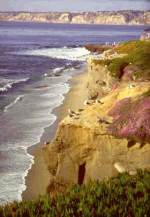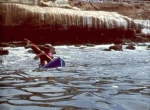May 1999, Vol. 3 No. 7
 Ocean kayaking may sound exotic, but it is actually accessible and enjoyable. On placid seas, like those of Southern California, it is a tranquil way to explore the coastline up close, without the distractions of large boats or crowds of people. Kayaking offers wonderful views of nearby shores, maybe even an intimate close-up of a craggy island. And close-up views of the sea life, both above and below the ocean surface, enhances the journey, which is also a great upper- body workout.
Ocean kayaking may sound exotic, but it is actually accessible and enjoyable. On placid seas, like those of Southern California, it is a tranquil way to explore the coastline up close, without the distractions of large boats or crowds of people. Kayaking offers wonderful views of nearby shores, maybe even an intimate close-up of a craggy island. And close-up views of the sea life, both above and below the ocean surface, enhances the journey, which is also a great upper- body workout.
Kayaking can lead you to an adventure destination or simply consume a few hours of your time. My husband David and I enjoy exploring by kayak. And while we’ve have taken a few challenging weekend kayak trips like those offered along the coastlines of Orcas Island in Puget Sound, California, Washington, Oregon, and Washington, whenever we visit, we still try to spend a couple of hours paddling rented kayaks along the shore in San Diego, California.
The beach at La Jolla, near San Diego, is idyllic. Sunlovers, lying on towels at the La Jolla Shores, seem mesmerized by the incoming swells of the Pacific Ocean. Some spend hours helping children build castles in the sand, while others are watching surfers catch a waves. In recent years, renting colorful kayaks to paddle near the shoreline has become a popular recreation.
Mike Luscomb, owner of La Jolla Kayak Company, is a native of the beachside town. His company offers guided half-mile tours during which the leader acts as both instructor and tour guide, sharing a wealth of information about the shores and the La Jolla caves.
If you’d rather go it alone, La Jolla Kayak Company, located three blocks from the Shores beach, includes delivery and pickup in their rental fee. They load the 45-pound polyeutherane polyurethane kayaks into their truck to and meet you at a specific location at at the beach. When you’re finished, you simply return their the paddle and lifejacket, so they know it’s time they’ll retrieve the kayak. This rental routine beats loading a heavy kayak onto the roof of your car a vehicle and hauling it to the beach.
 Buoys, located near the La Jolla caves, designate an area prohibited to motorized boats, part of the Scripps Ecological Underwater Park Reserve. There is a half-mile swimmer’s course from the beach to the buoys; you’ll be sharing your route with swimmers-and with the wildlife protected within the Reserve.
Buoys, located near the La Jolla caves, designate an area prohibited to motorized boats, part of the Scripps Ecological Underwater Park Reserve. There is a half-mile swimmer’s course from the beach to the buoys; you’ll be sharing your route with swimmers-and with the wildlife protected within the Reserve.
There is plenty of space for kayaking between the craggy shore and the no-boat zone, but more advanced kayakers can choose to paddle through a narrow channel to the caves.The passage into the cave isn’t long but it is narrow. The size of the ocean swells and your steering ability should dictate whether or not you can paddle through the channel; crashing into cave walls can be dangerous for you and the kayak.
Personal items, such as suntan lotion and a water bottle, can be carried in the storage bag attached to the back of your seat. La Jolla Kayak will provide watertight bags for your camera. Paddlers can also carry a mask and snorkel to enjoy underwater views. If you are certified for kayak scuba diving, you can anchor the kayak and descend into the depths.
For those who’ve never kayaked before, however, here’s how the process works: after briefing you onto some safety tips and directions, the instructor helps you into the seat of the kayak and steers you into the oncoming surf. Launching these colorful chartreuse kayaks is simple, albeit easier than landing them back on the beach…, but we’ will get to that part later.
 Once seated situated in the comfortable seat, with its full backrest, you have one crucial task: it’s key to keep the bow pointed directly into the direction of the surf. A wave hitting the side of the kayak will topple you into the ocean. The first task is to paddling beyond the breaking waves.
Once seated situated in the comfortable seat, with its full backrest, you have one crucial task: it’s key to keep the bow pointed directly into the direction of the surf. A wave hitting the side of the kayak will topple you into the ocean. The first task is to paddling beyond the breaking waves.
Now, you’ are ready to cruise. The most scenic paddle, and one of my favorites, is to follows the coastline southward, toward the a series of interesting caves, adjacent to the La Jolla cove.
There’s a lot to see this close to shore. If the visibility is good, you can weave your way through clusters of ocean kelp, catching glimpses of brilliant orange garibaldis. Schools of sardines break the surface of the water; the occasional bottom-dwelling leopard shark can be sighted in the shallower water near the shore. If it’s the right time of year, you’ll be able to hear the barking of sea lions, several colonies of which colonies, hanging out on the rocky cliffs, can be heard barking overlooking the shore.
 If your arms tire, you can lay back and float with the swells. Kayaking on a calm day in the ocean has a tranquilizing effect on the soul. Mike Luscomb, owner of La Jolla Kayak Company, is a native of La Jolla. His company offers guided half-mile tours while sharing a wealth of information about the shores and the La Jolla caves.
If your arms tire, you can lay back and float with the swells. Kayaking on a calm day in the ocean has a tranquilizing effect on the soul. Mike Luscomb, owner of La Jolla Kayak Company, is a native of La Jolla. His company offers guided half-mile tours while sharing a wealth of information about the shores and the La Jolla caves.
Buoys, located near the La Jolla caves, designate the prohibition of motorized boats. This area is part of the Scripps Ecological Underwater Park Reserve. There is a half-mile swimmer’s course from the beach and the no-boat zone protects the Reserve, as well as the swimmers.
There is plenty of space for kayaking between the craggy shore and the no-boat zone. The size of the ocean swells and the level of competence of steering ability should be the criteria as to whether or not to paddle through the channel passage of the caves. Crashing into cave walls can be dangerous for you and the kayak.
Personal items, such as sun tan lotion and a water bottle, can be carried in the personal storage bag attached to the back of your seat. La Jolla Kayak will provide watertight bags for your camera. Paddlers can also carry a mask and snorkel to enjoy underwater views. If you are certified for kayak scuba diving, you can anchor the kayak and descend into the depths.
 Since your arms serve as “the “engine”” of your kayak, this sport is can be a great upper body workout, but you can also choose to lay back and float with the swells. On a calm day, the rhythm of the sea has a tranquilizing effect on the soul:dawdle and float with the current.
Since your arms serve as “the “engine”” of your kayak, this sport is can be a great upper body workout, but you can also choose to lay back and float with the swells. On a calm day, the rhythm of the sea has a tranquilizing effect on the soul:dawdle and float with the current.
After your relaxation, though, you’ll face a challenge as the adventure peaks when it is time to return to the beach. Paddling toward the beach through the breaking waves of the surf is the most challenging part of ocean kayaking.
The paddler needs to ride the incoming waves, and being careful not to “catch an edge” or “pearl,” tipping part of the kayak into the water. Edging or pearling means you crash. If a wave does catch the kayak, causing it to turn over or pitch forward, you must lean your weight into the wave and “bail out”,the kayak will toss you into the water. (It is important if you do “crash” into the surf, to fall behind the kayak. This prevents you from being hit by the kayak as you follow it in to the beach.)
The possibility of having to “bail” depends on the height of the surf and your ability to coordinate your paddling while riding the incoming waves toward the shore. La Jolla Shores is a sheltered beach and usually has smaller surf; in a location like this, bailing out simply adds to the adventure!
 Beginners who are concerned about launching a kayak into the frigid 65-70 degrees of the Pacific Ocean, or who worrying about the possibility of an exciting landing, you might want to consider kayaking in the more protected Mission Bay, where the biggest wave you’ll encounter is the wake of a passing boat. Here, the only hazards are paddling into a dock or the path of an oncoming boat. Access to the kayak is made from a pier. If you’re interested, the San Diego Sailing Center and Mission Bay Sports Center offers lessons, rentals, and excursions within the bay.
Beginners who are concerned about launching a kayak into the frigid 65-70 degrees of the Pacific Ocean, or who worrying about the possibility of an exciting landing, you might want to consider kayaking in the more protected Mission Bay, where the biggest wave you’ll encounter is the wake of a passing boat. Here, the only hazards are paddling into a dock or the path of an oncoming boat. Access to the kayak is made from a pier. If you’re interested, the San Diego Sailing Center and Mission Bay Sports Center offers lessons, rentals, and excursions within the bay.
There is no need to worry about surf in the bay. The biggest wave will come from the wake of a passing boat. The only hazards are paddling into a dock or the path of an oncoming boat. Access to the kayak is made from a pier.
Whenever your adventures take you near the ocean, check out kayak rentals in the area. It’s better than lounging on the beach. For further information, e-mail [email protected]
